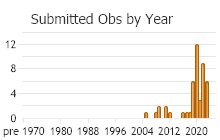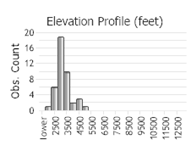View in other NatureServe Network Field Guides
NatureServe
Montana
Utah
Wyoming
Idaho
Wisconsin
British Columbia
South Carolina
Yukon
California
New York
Dingy Cutworm Moth - Feltia jaculifera
General Description
Feltia jaculifera is a complex of probably six or more sibling species, at least two of which occur in Alberta. These cannot by separated to species using normal means. In spite of extensive studies "jaculifera" is still best treated as a single "species" (Anweiler - E.H. Strickland Entomological Museum, University of Alberta). Feltia jaculifera is a medium-size moth (35 - 40 mm wingspan) with dark forewings broken up by a pattern of pale longitudinal streaks and spots. There is a long thick black basal dash, which includes the claviform spot, that is crossed by two narrow lines in the basal half. A pale median streak curves down at the anal angle to meet the one running along the lower margin of the wing. The costa is also pale, and is linked to the top of the pale reniform mad orbicular spots. The subterminal line is a series of pale streaks following the veins. The hindwing varies from white with light fuscous shading along the margin to mostly fuscous, but is usually dirty white with a broad diffuse darker margin (Powell and Opler, 2009).
Phenology
Adult Dingy Cutworm Moths fly from late June to early November. They can be seen flying in many areas including fields, gardens, waste areas. Adults are nocturnal. However, in more arid areas adults can be found nectaring and resting on composite flowers such as Helianthus, Grindelia, and Solidago (Asteraceae) in the late afternoon (Powell and Opler 2009). Females will oviposit in flower heads, particularly in the heads of Asteraceae. There is a single annual brood. The larvae overwinter and emerge in the spring. They overwinter as partially grown (third and fourth instar) larvae (Anweiler 2007).
Diagnostic Characteristics
F. jaculifera is most likely a species group of six or more separate, but currently inseparable species (Powell and Opler 2009). In the province of Alberta, F. jaculifera is most likely to be confused only with the Master's Dart (F. herilis), which is darker and has a less complex and contrasting pattern (Anweiler 2007).
Species Range
Montana Range
Range Descriptions

 Native
Native
Range Comments
The Dingy Cutworm Moth is common throughout North America including eastern North America. It ranges from eastern Alaska to the Canadian Maritimes (Atlantic coast), south long both coasts and into northern Mexico, except much of California, southern Nevada, and much of the Mississippi Valley, southeastern coastal plains, and peninsular Florida (Powell and Opler 2009).
Observations in Montana Natural Heritage Program Database
Number of Observations: 93
(Click on the following maps and charts to see full sized version)
Map Help and Descriptions
Relative Density

Recency



 (Observations spanning multiple months or years are excluded from time charts)
(Observations spanning multiple months or years are excluded from time charts)
Habitat
The Dingy Cutworm Moth is found in open habitats, in particular, native grasslands. It is also found in riparian edges, meadows, and other open areas (Anweiler 2007).
Food Habits
Young larvae may have specific feeding requirements, but later instars are general feeders on a variety of herbs and forbs (Anweiler 2007).
Stewardship Responsibility
References
- Literature Cited AboveLegend:
 View Online Publication
View Online Publication Powell, J.A. and P.A. Opler. 2009. Moths of Western North America. University of California Press, Berkeley, CA. 369 pp.
Powell, J.A. and P.A. Opler. 2009. Moths of Western North America. University of California Press, Berkeley, CA. 369 pp.
- Additional ReferencesLegend:
 View Online Publication
View Online Publication
Do you know of a citation we're missing? Martin, S. 1933. Serological studies of moth proteins with special reference to specific immune bodies and their phylogenetic significance. M.Sc. Thesis. Bozeman, MT: Montana State College. 26 p.
Martin, S. 1933. Serological studies of moth proteins with special reference to specific immune bodies and their phylogenetic significance. M.Sc. Thesis. Bozeman, MT: Montana State College. 26 p. Sater, S. 2022. The insects of Sevenmile Creek, a pictorial guide to their diversity and ecology. Undergraduate Thesis. Helena, MT: Carroll College. 242 p.
Sater, S. 2022. The insects of Sevenmile Creek, a pictorial guide to their diversity and ecology. Undergraduate Thesis. Helena, MT: Carroll College. 242 p.
- Web Search Engines for Articles on "Dingy Cutworm Moth"
- Additional Sources of Information Related to "Insects"





